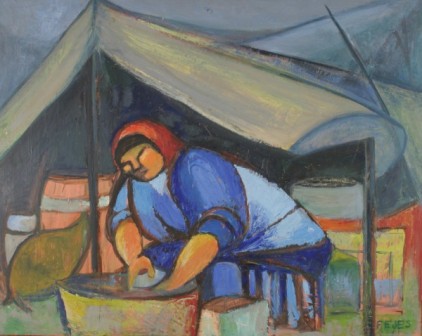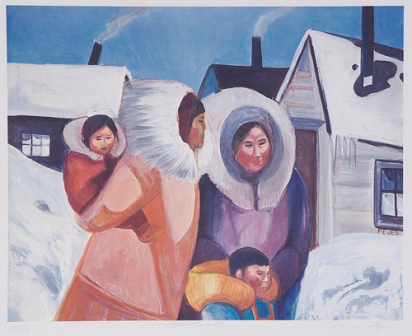|
Claire Specht Fejes was born in New York October 1920. She trained in anatomy, stone-carving, and sculpture at the Newark Museum, Newark Fine Arts School, and the Students' Art League through the Works Progress Administration. Claire married Joe Fejes in 1942 and moved with him to Fairbanks, Alaska in 1946 where her husband took up gold mining. Claire Fejes sketched and painted Alaska Native people, Inupiat and Athabascans. Her bold use of color and form evoke the essence of the North in all its beauty and power. She also wrote books about her travels and life in Alaska.
Born in New York to immigrant parents from Austria and Poland, Claire Fejes’ artistic life was forged by the Depression years. She received her art training through museum-based WPA arts projects in Manhattan, intending to work as a sculptor. She abandoned sculpture as impractical, turning to oils.For a decade, Fejes painted on a small kitchen table near the cabin’s wood stove: self-portraits, nudes, the neighbors, scenes from the valley and woods. Local Athabascan and Eskimo women sat for her, and Claire Fejes grew fascinated with their stories and the subsistence life they described far from town.
In 1958, Claire Fejes made a breakaway decision. Packing her painting supplies, a tent, and some food, she traveled to Sesaulik, an Inupiat whaling camp on Alaska’s arctic coast. The experience was transformational. On her return she produced twenty oils, dubbed the Sesaulik 20, in a rush of creativity, working with a palette knife on masonite. The experience set her style – unplanned, swift, and emotionally intense – based on a deep immersion in her subject.
The Sesaulik 20 captured interest beyond Alaska. Seattle’s Frye Art Museum invited Fejes to mount a one-woman show, and its good review led to a solo exhibit at the Roko Gallery in New York. Writing in journals since her childhood, Claire Fejes not only painted but was also a write, publishing four books about her travels, painting, and life in Alaska. In her last decade, Claire Fejes spent winters in New York and San Diego, and her summers in Alaska. As she had for half a century, she wrote and painted in Fairbanks. Of Alaska, she said: 'This is my inspiration. I don’t feel like painting in New York or any other place. This is where I’m inspired by the people and the land. This is my inspiration here. It just comes pouring out of me when I’m here. When I’m any other place, I don’t even want to paint.' Claire Fejes passed away in 1998 but her legacy lives on. Elegant line drawings by Claire Fejes illustrate the characters and key events of the folk stories in "The Eskimo Storyteller" by Edwin S. Hall Jr. Now a classic in northern literature, The Eskimo Storyteller brings to life the words of Eskimo elders for a new generation of readers. This collection of folktales from northwest Alaska includes stories populated by amazing creatures, hard-bitten hunters, and strong-minded women. Two master storytellers, Edna Hunnicutt and Paul Monroe, introduce readers to the guiding principles of daily life in the Arctic and chronicle the devastating results when those principles are violated.
Johnny Aculiak| Edwin Tappan Adney|
George Twok Aden Ahgupuk| Alvin Eli Amason| Saradell Ard| Belmore Browne| Vincent Colyer| Jules Bernard Dahlager| Lockwood De Forest| Frederick Samuel Dellenbaugh| William Franklin Draper| | Henry Wood Elliott| John Fehringer| Claire Fejes| Louis Agassiz Fuertes| Magnus Colcord Heurlin| Norman Jackson| Rockwell Kent| Sydney Mortimer Laurence| Fred Machetanz| Marvin Mangus| Milo Minock| James Kivetoruk Moses| Rie Munoz| Joseph Henry Sharp| James Everett Stuart| John Webber| Kesler Woodward|
|




